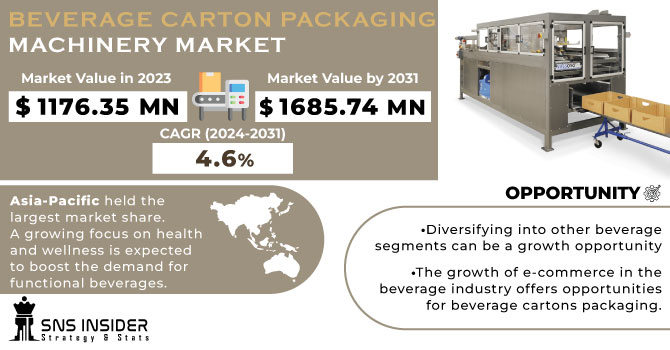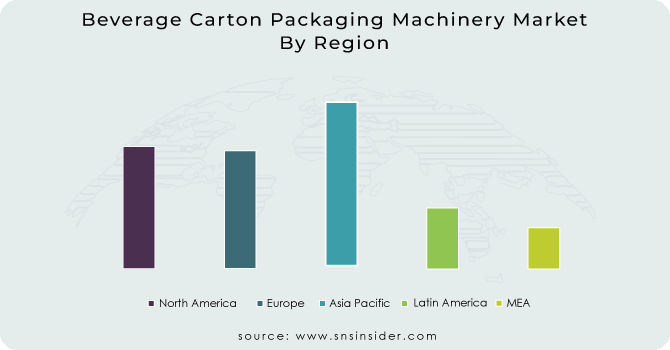Beverage Carton Packaging Machinery Market Key Insights:
The Beverage Carton Packaging Machinery Market size was USD 1176.35 million in 2023 and is expected to Reach USD 1685.74 million by 2031 and grow at a CAGR of 4.6 % over the forecast period of 2024-2031.
Rising concerns over plastic waste and its negative impact on the environment, along with increasing demand for beverages, are expected to boost the demand for beverage carton packaging machines during the forecast period. In addition, changing lifestyles and growing interest in convenience are increasing the demand for ready-to-drink beverages, which should have a positive impact on the growth of the beverage carton packaging machine market. Moreover, with the overall beverage industry growing all over the world, the demand for beverage carton packaging machines is expected to grow even more in the coming years.

Get More Information on Beverage Carton Packaging Machinery Market - Request Sample Report
The United States dominated the market in North America region. The horizontal end-side loading carton segment has the largest market share in the United States and is expected to maintain its dominance during the forecast period. The ability to operate at high speed is expected to drive demand in this segment, especially when dealing with large volumes of goods.
The increasing focus on functional food automation for increased productivity and the increasing variety of beverage products are driving the demand for high-speed beverage carton packaging machines.
Manufacturers operating in the end-use industry offer customized products, including beverage carton packaging machines, in terms of specifications such as speed, packs per minute, package type, drive system, industrial sensors, safety components, human-machine interface, and more. Selective (HMI used for this kind of machine) or programmable controller is used. Beverage carton packaging machine suppliers therefore offer bespoke designs to meet customer needs. The above factors along with material costs, construction costs, labor costs and profit margins contribute to the overall cost of beverage carton packaging machines. Hence, the increasing demand for customized carton packaging machines is expected to boost the market in future. However, the high acquisition costs associated with carton wrapping machines can limit their acceptance, especially among smaller suppliers, thereby inhibiting the market.
MARKET DYNAMICS
KEY DRIVERS:
-
Increasing consumption of beverages is driving the growth of market
The global food & beverage industry is growing steadily due to factors such as population growth, changing consumer preferences and rising disposable income. As the demand for beverages such as juices, dairy products and soft drinks increases, so does the need for suitable packaging solutions such as beverage cartons.
-
The market for disposable and takeaway beverages is growing rapidly
RESTRAIN:
-
Unavailability of raw material for production is major concern
Beverage boxes are made from renewable resources like cardboard, but their manufacturing process can involve environmental problems, such as deforestation and energy consumption. Sustainable sourcing of raw materials, responsible forestry practices and minimizing the environmental impact of beverage packaging are significant challenges faced by manufacturers.
OPPORTUNITY:
-
Diversifying into other beverage segments can be a growth opportunity
Beverage carton manufacturers can explore opportunities to diversify their product portfolio by targeting new beverage segments. Expanding into segments such as functional drinks, sports drinks, ready-to-drink coffee and alcoholic beverages could open up new avenues of growth. Tailoring carton designs and features to meet the specific requirements of these beverage segments can help manufacturers gain market share.
-
The growth of e-commerce in the beverage industry offers opportunities for beverage cartons packaging.
CHALLENGES:
-
Competition from other packaging industry
Beverage boxes face competition from alternative forms of packaging such as plastic bottles, aluminum cans, and glass bottles. These packaging formats have their own advantages, including aesthetics, durability, and product compatibility. The challenge for beverage carton manufacturers is to differentiate their products and convince beverage manufacturers and consumers of the unique benefits that carton packaging offers.
IMPACT OF RUSSIAN UKRAINE WAR
Russia's consumer spending - which corresponds to 48% of the country's GDP - is expected to plummet by 2022. Falling incomes are prompting consumers to change their purchasing habits and switch to cheaper options than. Restrictions on freedoms, severe penalties, rising inflation, falling disposable income and rising unemployment led to increased migration.
Russia is seen as a target market for future expansion by large international companies that are limiting or terminating their presence in the country. In addition to category restrictions imposed by major international companies suspending imports and production, knock-on effects are having a severe impact on Russian industries. International drinks have faced significant price increases as well as the proliferation of local analogs that have lurked. The practice of promotions with constant prices is paused. This situation has also hindered international market players who have decided to stay in Russia and who depend on imported resources.
Since beverage consumption was affected it had a direct impact on production and the machinery involved in production.
IMPACT OF ONGOING RECESSION
During an economic downturn, consumers can reduce discretionary spending, including on non-essential items like beverages. Reduced consumption can lead to lower production volumes for beverage manufacturers, resulting in lower demand for packaging machinery.
Decreased consumer spending and a drop in the per capita income of consumers is affecting the market. In times of recession, people tend to save money. Consumer behavior will affect this market.
New innovative innovations and machinery will not come during time of recession due to the less spending of industries on R&D. This is because industries will not choose to spend money at times of recession due to loss and changes economy.
KEY MARKET SEGMENTS:
By Type
-
Top Load Cartoner
-
Horizontal End Side-Load Cartoner
-
Wraparound Cartoner
-
Others
By Function
-
Automatic
-
Semi-automatic
By Application
-
Alcoholic Beverages
-
Dairy Beverages
REGIONAL ANALYSIS
Asia-Pacific held the largest market share. A growing focus on health and wellness is expected to boost the demand for functional beverages. Moreover, rising disposable incomes, especially in countries such as China and India, will boost the demand for premium beverage products, which should have a positive impact on the market.
In North America, the market is expected to grow at a rate of 4.5% during the forecast period. Growing demand for premium and ultra-premium beverages and increasing demand for ready-to-eat non-alcoholic beverages are expected to have a positive impact on the beverage carton packaging machinery market in the region.
Additionally, the growth of cocktail culture and social media is likely to continue to increase demand for beverages in the years to come. Additionally, rising demand for various alcoholic beverages such as craft beer, canned wine, and bottled cocktails is expected to drive market growth during the forecast period. Moreover, the increasing number of breweries in North America is expected to continue to have a positive impact on the beverage carton packaging machine market.
In Europe, the market is expected to grow at a CAGR of 4% during the forecast period. Countries such as Italy, Spain, and France are among the world's largest wine producers. In addition, the increasing focus on sustainability, especially in this region, is increasing the demand for eco-friendly packaging materials such as corrugated boards, which is expected to contribute to the growth of the market.

Get Customized Report as per your Business Requirement - Request For Customized Report
REGIONAL COVERAGE:
North America
-
US
-
Canada
-
Mexico
Europe
-
Eastern Europe
-
Poland
-
Romania
-
Hungary
-
Turkey
-
Rest of Eastern Europe
-
-
Western Europe
-
Germany
-
France
-
UK
-
Italy
-
Spain
-
Netherlands
-
Switzerland
-
Austria
-
Rest of Western Europe
-
Asia Pacific
-
China
-
India
-
Japan
-
South Korea
-
Vietnam
-
Singapore
-
Australia
-
Rest of Asia Pacific
Middle East & Africa
-
Middle East
-
UAE
-
Egypt
-
Saudi Arabia
-
Qatar
-
Rest of Middle East
-
-
Africa
-
Nigeria
-
South Africa
-
Rest of Africa
-
Latin America
-
Brazil
-
Argentina
-
Colombia
-
Rest of Latin America
Key Players:
Some major key players in the Beverage Carton Packaging Machinery Market are Jacob White Packaging Ltd, Douglas Machine Inc, Krones AG, Tishma Technologies, Cariba S.r.l, R.A. Jones, Mpac Group plc, Syntegon Technology GmbH, Bradman Lake Group Ltd, KHS GmbH and other players.
Douglas Machine Inc-Company Financial Analysis

RECENT DEVELOPMENTS:
-
Andritz supplies beverage carton recycling line to Vietnam's Dong Thien Binh Duong Paper
-
Tetra Pak, Three new ready to drink cocktails in the environmentally conscious carton packaging of Tetra Pak were released by American tequila company, Dulce Vida a US-based brand.
| Report Attributes | Details |
| Market Size in 2023 | US$ 1176.35 Mn |
| Market Size by 2031 | US$ 1685.74 Mn |
| CAGR | CAGR of 4.6% From 2024 to 2031 |
| Base Year | 2023 |
| Forecast Period | 2024-2031 |
| Historical Data | 2020-2022 |
| Report Scope & Coverage | Market Size, Segments Analysis, Competitive Landscape, Regional Analysis, DROC & SWOT Analysis, Forecast Outlook |
| Key Segments | • By Type (Top Load Cartoner, Horizontal End Side-Load Cartoner, Wrap around Cartoner, Others) • By Function (Automatic, Semi-automatic) • By Application (Alcoholic Beverages, Alcoholic Beverages, Non-alcoholic Beverages, Dairy Beverages) |
| Regional Analysis/Coverage | North America (US, Canada, Mexico), Europe (Eastern Europe [Poland, Romania, Hungary, Turkey, Rest of Eastern Europe] Western Europe] Germany, France, UK, Italy, Spain, Netherlands, Switzerland, Austria, Rest of Western Europe]). Asia Pacific (China, India, Japan, South Korea, Vietnam, Singapore, Australia, Rest of Asia Pacific), Middle East & Africa (Middle East [UAE, Egypt, Saudi Arabia, Qatar, Rest of Middle East], Africa [Nigeria, South Africa, Rest of Africa], Latin America (Brazil, Argentina, Colombia Rest of Latin America) |
| Company Profiles | Jacob White Packaging Ltd, Douglas Machine Inc, Krones AG, Tishma Technologies, Cariba S.r.l, R.A. Jones, Mpac Group plc, Syntegon Technology GmbH, Bradman Lake Group Ltd, KHS GmbH |
| Key Drivers | • Increasing consumption of beverages is driving the growth of market |
| Market Restraints | • Diversifying into other beverage segments can be a growth opportunity |

